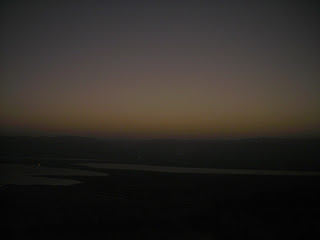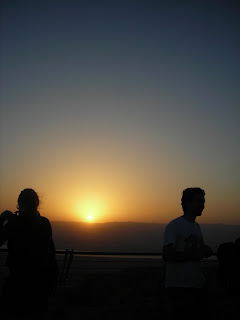We left at 2:30 in the morning from Jerusalem. The bus ride was long (a little over two hours) and unfortunately I got a bit sick. Next time I'll remember to take motion sickness pills. When we got to the Roman Trail (the thankfully shorter trail) we hiked up as a group, in about 15 minutes. It was a short but steep walk and everyone was out of breath when we reached the top.
Then, we watched the sun rise before starting our tour. We split up into two groups and I have no idea if the other group saw the same things we did. First, we went to the bathhouse that King Herod built. Apparently Herod, who is best known for rebuilding the Second Temple, built Masada as a retreat in case of a siege or revolt. He created a luxurious bathhouse and archaeologists found evidence of both figs and grapes. The bathhouse itself had multiple parts, including a gymnasium and a room similar to a sauna. (The floor was built on top of beams, and wood was burned beneath, keeping the floor warm. Cold water was then thrown on top of the floor, to create steam).
After Herod's death, Masada was inhabited by a radical group of Jews (known as the Zealots or Sicarii) during the war against the Romans. The Sicarii on Masada were commanded by Elazar ben Ya'ir. In 72 CE, two years after the destruction of the Second Temple, a Roman General named Silva lay siege to Masada.
He and his men, possibly with the help of Jewish slaves, built the Roman ramp to reach the Jews.
The Jews, observing this work, knew that soon the Romans would reach them. They had enough food for a long siege; however, they could not fight a legion (10,000) of Roman soldiers. So, Elazar ben Ya'ir, their leader, decided upon a different course of action. According to Josephus, Elazar gathered all the Jews and gave a speech, calling for the Jews to kill themselves before being taken by the Romans. Almost everyone agreed. Women killed their children, men their wives, until only ten men remained. These ten men wrote down their names on clay tablets (later found by archaeologists) and drew lots to determine who would kill whom. The last man committed suicide.
The account of the siege of Masada was related to Josephus by two women who survived the suicide by hiding inside a cistern along with five children. Josephus' account is the only account of the events on Masada that survives today.
Anyway, after that rather depressing history, here are some pictures of Masada:
 |
| The bathhouse |
 |
| The synagogue |




























No comments:
Post a Comment